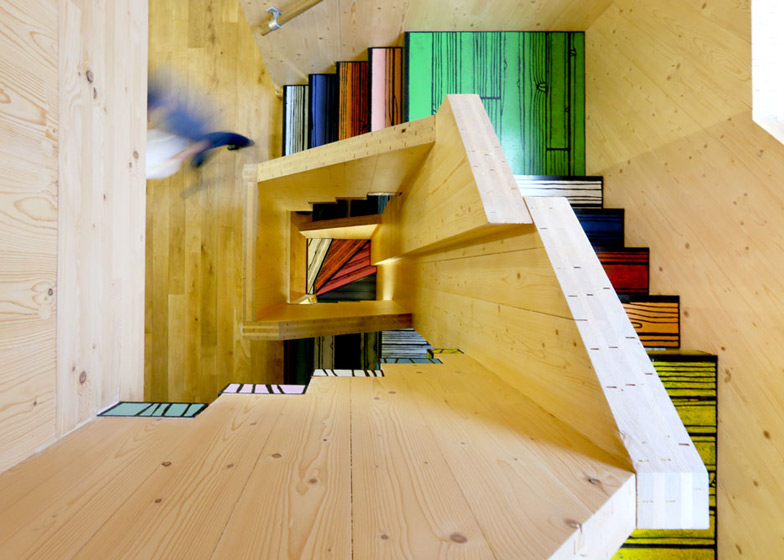London studio dRMM has completed a house and studio for Hackney artist Richard Woods, using his trademark cartoon-style print to add colour to the building's facade and staircase (+ slideshow).
Richard Woods is best known for the painted woodgrain graphics he applies to furniture and textiles, so dRMM used the pattern to inject the character of the artist into the architectural design.
Panels in shades of white, yellow and green run horizontally along patches of the front and rear facades. They reappear inside the house as treads for the main staircase, which features a rainbow of colours ranging from pale pink and white to bold reds, blues and greens.
Entitled WoodBlock House, the project is described by the designers as "a chance for experimentation that resulted in domestic joy and Spartan pleasure in every aspect of the finished product".
Functions inside the three-storey building are divided up by storey. A large-scale printing workshop occupies the entire ground floor, while the level above accommodates living spaces and the second storey contains four bedrooms for Woods' family.
Externally, only the bedroom storey is clad with the colourful plywood. The rest of the exterior is clad with unpainted larch boards that are arranged vertically to contrast.
Timber also lines the walls, floors and ceilings of the two domestic floors. "WoodBlock House also has the unique atmosphere of a house built only in timber and glass, with a sensual quality that has to be seen, touched and smelt to be fully understood," said dRMM in a statement.
The studio opens out to a yard at the back, ensuring easy access and constant ventilation, while the dining room leads to a balcony terrace where residents can dine al fresco.
The staircase also ascends to another terrace on the roof, which is accessed via a small library.
dRMM used a cross-laminated timber structural system to build the house. Only two types of windows were used, which include full-height sliding windows for the living rooms and smaller "punched hole" windows for bedrooms and corridors.
The interior is completed by a wood-burning stove, leather seating and a few select pieces of furniture by the artist.
This isn't the first time dRMM has collaborated with Richard Woods. The pair previously worked together to create a gallery space for Modern Art Oxford.
Photography is by Alex de Rijke.
Here's a project description from dRMM:
WoodBlock House, Hackney, London
WoodBlock House demonstrates a genuine collaboration between architect and client, a chance for experimentation that resulted in domestic joy and Spartan pleasure in every aspect of the finished product.
The brief was to create a studio, home and office for UK artist Richards Woods and his family. Woods' working process requires a large-scale printing workshop where work can be manufactured with adequate space for him and his studio employees. The building had to be designed with the inclusion of an open yard at ground level, to ensure ventilation and ease of access – both essential to Woods' work process. From the start designs evolved from extensive conversations with the client, whose own work traverses the boundaries between art, architecture and furniture design in the interplay between the functional and the ornamental.
The result was a simple, large workshop and printing studio space on the ground floor, with separate living accommodation above, all characterised by the qualities of timber, good spaces and daylight. The design principles of the scheme can be grouped as follows:
Articulated Massing
The massing and CLT panel structural system is expressed through the articulation of the facade in relief and choice of cladding. The building consists of three elements, the ground and first floor housing workshop and main living area, the second floor box of bedrooms with small rooftop library on the third floor. The building is positioned slightly away from its neighbours flank wall to include the careful brickwork in its composition.
Timber cladding
The home section of the building is south-facing and sits on top of the north-facing studio. The former is horizontally clad painted plywood using a printing technique for which the artist-client is internationally renown; by contrast the studio is clad in unpainted larch.
Fenestration Principles
A simple, generous fenestration specification has been used throughout. Generally there are two types of window – full height, sliding windows to principal living areas, and smaller 'punched hole' windows to secondary living spaces such as bedrooms and circulation. All are laminated timber.
The building is a response to the family's needs, as well as dRMM's own commitment to sustainability in architecture through the use of engineered timber. Panelised construction was far quicker than an equivalent brick or concrete construction, and since noise, pollution and site traffic are lessened, relations with the neighbours were good throughout.
Apart from being environmentally sound, WoodBlock House also has the unique atmosphere of a house built only in timber and glass, with a sensual quality that has to be seen, touched and smelt to be fully understood. But perhaps its greatest success lies in something even more intangible: the feeling of a building that is in constant use, brought to life through the noisy combination of family, work and play.







